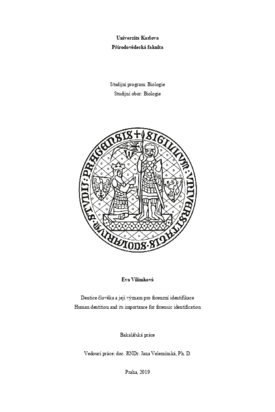Dentice člověka a její význam pro forenzní identifikace
Human dentition and its importance for forensic identification
bakalářská práce (OBHÁJENO)

Zobrazit/
Trvalý odkaz
http://hdl.handle.net/20.500.11956/106773Identifikátory
SIS: 197589
Kolekce
- Kvalifikační práce [21483]
Autor
Vedoucí práce
Oponent práce
Bejdová, Šárka
Fakulta / součást
Přírodovědecká fakulta
Obor
Biologie
Katedra / ústav / klinika
Katedra antropologie a genetiky člověka
Datum obhajoby
5. 6. 2019
Nakladatel
Univerzita Karlova, Přírodovědecká fakultaJazyk
Čeština
Známka
Výborně
Klíčová slova (česky)
identifikace, forenzní odontologie, stopy po kousnutí, otisky rtůKlíčová slova (anglicky)
identification, forensic odontology, bitemarks, lip printsV případě nálezu neznámého mrtvého těla je třeba tuto osobu identifikovat. Vedle vizuální identifikace, identifikace na základě otisků prstů a DNA identifikace je hojně využívaným přístupem forenzní odontologie. Během vyšetřování jsou získány antemortem zubní záznamy a probíhá jejich komparace s postmortem nálezem. Nejčastěji jsou analyzovány RTG snímky dentice. Na snímcích mohou být zobrazeny sanační zásahy, které jsou velmi spolehlivým identifikačním znakem. V případě nálezu pozůstatků bez zubů také existují různé možnosti, jak danou osobu ztotožnit. Forenzní odontologie se ale nezabývá pouze identifikací zemřelých, uplatňuje se také při analýze stop po kousnutí, případně lze zkoumat i otisky rtů zanechané na místě činu a jejich přiřazení k osobě, která otisk zanechala. Klíčová slova: identifikace, forenzní odontologie, stopy po kousnutí, otisky rtů
When an unknown cadaver is found it is necessary to identify it. In addition to visual identification, finger print analysis and DNA analysis can also be used to identify it. There is also a possibility of dental identification which is a frequently used approach. During the investigation, antemortem dental records are obtained and then compared with postmortem dental findings. X-ray images of dentition are the most often analyzed material. Dental restorations can be seen on these images and they are reliable identification features. In the case where toothless remains are found there is still a variety of options how to identify the person. However, forensic odontology does not only deal with the identification of the deceased but it is also applied to the analysis of bitemarks or it is also possible to examine lip prints left at the crime scene and their assignment to the person who left the lip print. Keywords: identification, forensic odontology, bitemarks, lip prints
